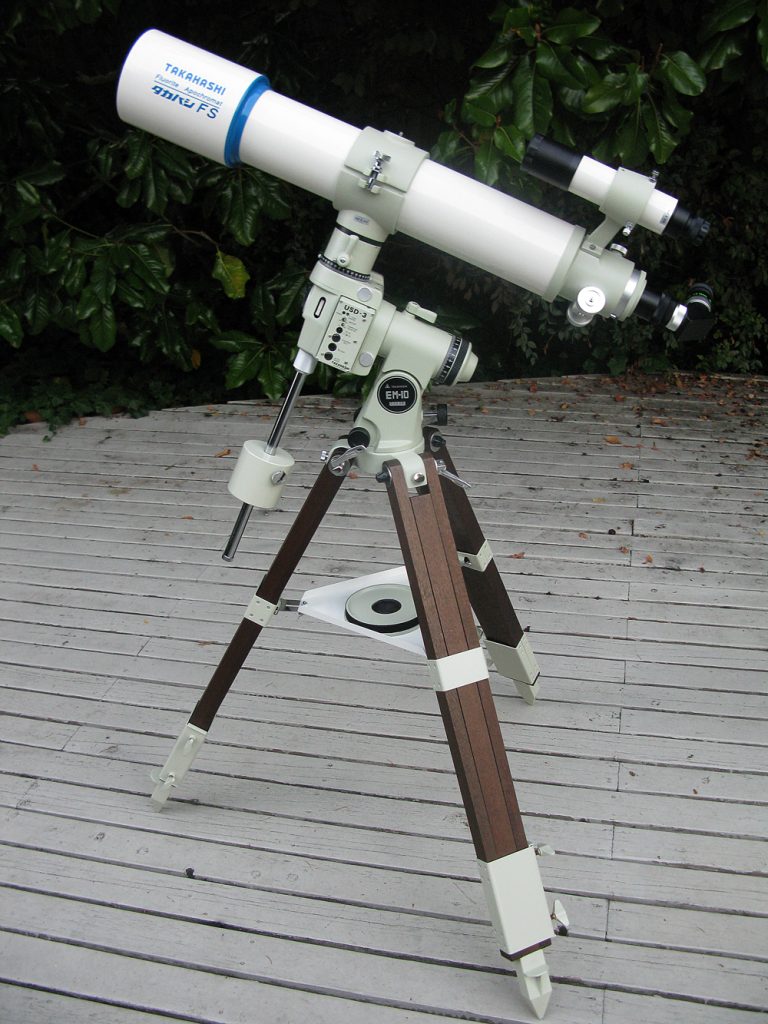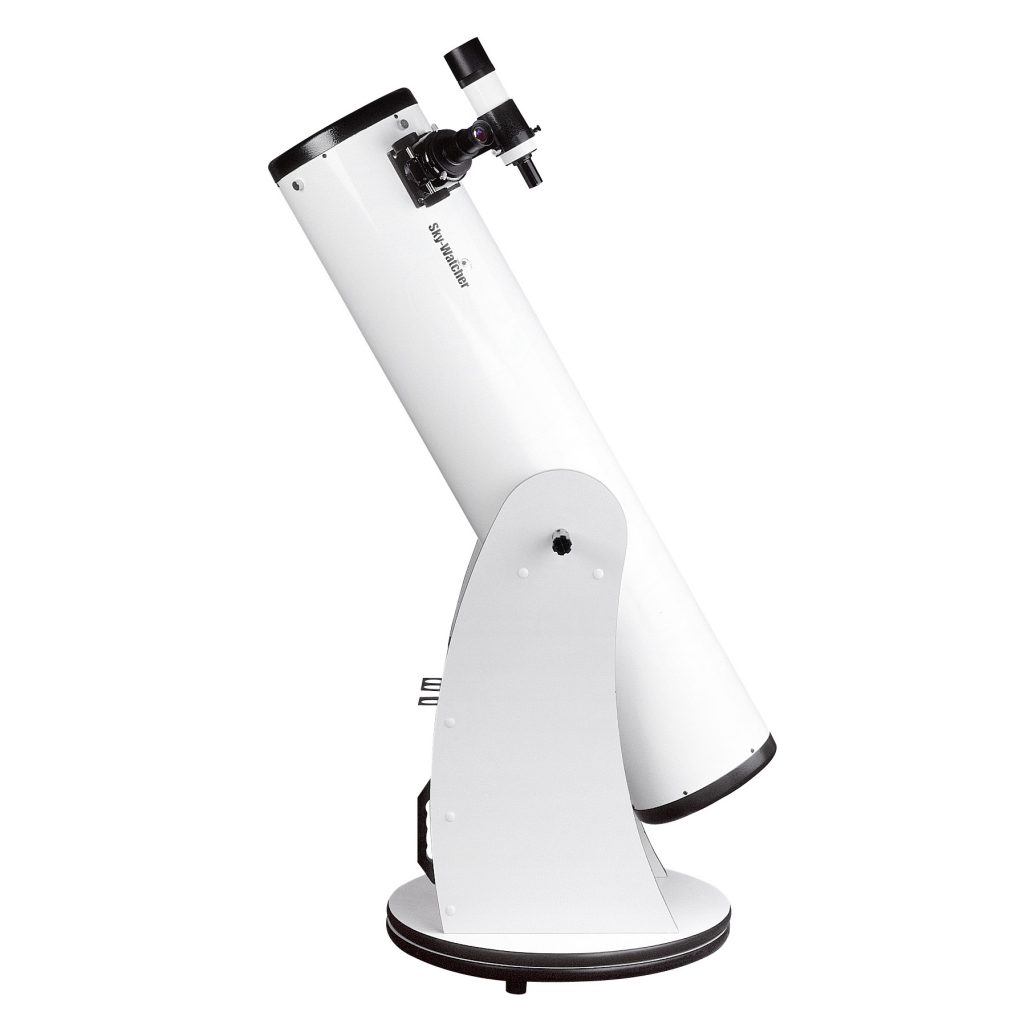APRIL 2017
A tale of two scopes.
An article in the author’s Astronomy Digest – https://www.ianmorison.com
To show that one does not have to spend vast amounts to obtain great views of the stars and planets – and also that where a telescope is located can have quite a bearing on the image quality a telescope can attain.
When Mars was closest to the Earth in August 2003, the Macclesfield Astronomical Society held a star party at Jodrell Bank and quite a number of telescopes were set up to observe it. As the evening progressed a consensus arose that two scopes were giving particularly good images: my own FS102, 4-inch Takahashi Fluorite Refractor (at around £2,500 pounds with its mount) and an 8-inch Dobsonian Newtonian newly bought for just £200. I personally preferred the view through the f6 Newtonian but others though that the f/8 FS102 gave a slightly better image so we will call it a draw! In this article I would like to discuss why these two performed so well and, just as importantly, why perhaps the others had not.

Takahashi FS102
The majority of scopes had been set up on a large concrete patio outside our visitor centre, but the FS102 and Dobsonian were on grass and not observing over the patio. This, I believe, was the major reason why these two scopes had performed so well. During the day (remember it was August) the concrete will have absorbed heat which is then released during the evening causing localized air turbulence through which the scopes mounted on the patio were viewing Mars. It is not therefore surprising, that the two mounted on grass should perform better. One of the world’s top Solar telescopes − the Big Bear Solar Observatory − rises out of a lake so that it is almost totally surrounded by water in order to minimise any local thermal effects. One of my friends went to Egypt to observe the transit of Venus in 2004. It was very hot in the holiday complex and he said that it would have been nice to observe from the shallow end of the swimming pool. I suspect that, had he done so, he would have had steadier images too! An obvious piece of related advice is that when observing the planets, particularly in winter, is not to observe them over rooftops as the turbulence caused by the escaping heat will severely degrade the image. One of the country’s leading astrophotographers, Peter Shah, has recently lagged the concrete pier on which his telescope is mounted to improve its imaging quality!

Sky Watcher 8-inch Dobsonian
The second reason why I suspect that the two scopes performed so well is that they are simple. The FS102 has a two element objective one of which is made of fluorite to give it a virtually colour free image. One key requirement for planetary imaging is high contrast and refractors excel at this with well baffled tubes and multicoated lens elements that scatter very little light. It happens that fluorite elements essentially scatter no light and this is one reason why the FS series of Flourite Takahashi scopes (sadly no longer made) are said to have the highest contrast of any telescope. The Dobsonian was brand new and thus its mirrors would have been in very good condition. Incidently, the latest multi-coated mirror surfaces scatter far less light − so will give higher contrast − and are thus well worth paying extra for if an option when buying a telescope. It appears too that they have a far longer life too.
The optical performance of a colour-free refractor is essentially perfect and limited solely by the aperture. This determines the resolution and so determines the finest detail that can be seen. A Newtonian has, however, two features that degrade the optical performance: the spider that supports the secondary mirror (which causes the, rather pretty, diffraction spikes seen with brighter star images) and the secondary mirror itself which also degrades the image somewhat. Both effects spread light a little away from where it should be and so reduce what I call the micro-contrast of the image. But wait. The Dobsonian had twice the aperture so, if theoretically perfect, would have twice the resolution of the FS102. The diffraction effects of the secondary depend somewhat on the ‘seeing’ − the steadiness of the atmosphere − but, even at worst, would still equal that of the 4 inch refractor! Newtonians suffer from ‘coma’ − stars begin to look like little comets away from the centre of the field of view, but of course when observing planets in the centre of the field this would have no effect. Finally the 8” Dobsonian will collect four times as much light as the 4” FS102 and that must help too, so it’s not too surprising that the two gave comparable performance.
The Dobsonian would have come with two simple eyepieces made with just three elements rather than the four, five or even seven element designs probably used with the more expensive telescopes. In one sense, the fewer elements the better as there are fewer surfaces for light to scatter from and some planetary observers even use ‘monocentric’ eyepieces made from a single piece of glass. A three element eyepiece will not have such a wide field of view as more complex designs and will tend to show some false colour towards the field edges but this is no problem when observing in the centre of the field and so a simple triplet eyepiece may actually perform better for planetary observing!
I have tried to explain why the two scopes could perform equally well and one reason why the others may not have done so well – their location. But there could have been two further reasons, particularly with the more complex ‘catadioptric’ telescopes − those that use both lenses and mirrors to form an image. These tend to need longer for the tube interior to cool down to ambient temperature (if an out-of-focus star image appears to be ‘bleeding’, it needs more time). The other reason is that the image quality falls off rapidly if the telescope is not well collimated. The ultimate test for this is to see that the ‘shadow’ of the secondary mirror is at the dead centre of an out-of-focus stellar image.
The lessons for us that come out of this tale are firstly, think about where you site your telescope, secondly, make sure your scope is cooled down and is well collimated and finally (and most important), you do not need to spend large amounts of money to achieve exquisite views of the heavens!